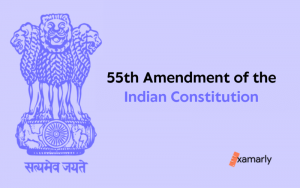For 320 years, a large part of South Asia was under the control of the Delhi Sultanate, an Islamic empire. Delhi served as the Sultanate’s capital, but it also served as much more.
The architecture of the Sultanate era is an excellent example of the fusion of various styles and features to create a new one. The structures built by Muslim monarchs exhibit many traits of Indian architecture. This occurred because Hindu craftsmen actually constructed the buildings, despite the fact that Muslim architects had designed them to meet their religion’s standards.
In the UPSC exam, questions about the art and architecture of Delhi Sultanate are frequently posed. This article is worth reading as it covers these beautiful structures and impressive buildings which were erected during that time.
- Art and Architecture of Delhi Sultanate: Features
- Art and Architecture of Delhi Sultanate
- Qutb Minar
- Double Dome
- Tughlaqabad Fort
- Alai Minar
- Alai Darwaza/Darwaja
- Quwwat-ul-Islam Mosque
- Tomb of Iltutmish
- Hauz Khas Complex
- Hazrat Nizamuddin Aulia Dargah
- Lodhi/Lodi Gardens
- Delhi Sultanate Art: Literature
- Conclusion
- FAQs on Art and Architecture of Delhi Sultanate
- What was the Delhi Sultanate?
- What were the major architectural achievements of the Delhi Sultanate?
- Who were the major patrons of art and architecture during the Delhi Sultanate?
- What were the major artistic traditions of the Delhi Sultanate?
- What is the Qutub Minar?
- What is the Alai Darwaza?
- What is the Jama Masjid?
- What is the Tomb of Ghiyasuddin Tughlaq?
Art and Architecture of Delhi Sultanate: Features
This Indo-Islamic style represents the esthetical heritage of the emerging sultans, which includes secular as well as religious structures.
The Turkish conquerors introduced new architectural styles such as:
- the vault,
- dome,
- tall towers, and
- the real arch without beams.
They also carried with them a wealth of information regarding the use of mortar and concrete, which had previously been sparingly employed in India. The Delhi Sultans were generous supporters of architecture and built many magnificent structures.
Some of the features of art and architecture of Sultanate of Delhi are:
- Muslim structures incorporate Hindu architectural features.
- The emergence of a distinctive Islamic aesthetic that combined aspects from India, Central Asia, and Persia.
- The building of the Arch and Dome gained popularity.
- The artwork consisted of pillars, jalis, and chhatris.
- The stones are set in excellent mortar.
- Building techniques were modified when lime mortar was used to create dwellings and structures.
- It makes use of the slab and beam method.
- Synthesis of native motifs, including the ball and lotus.
- The construction of vast halls with clear views was only possible by the arch and dome approach. This method eliminated the need for a significant amount of pillars to hold the roof.
The pointed arches are the Sultanate style of architecture’s most distinctive characteristics. These arches are built of slanting stones and do not rely on support. These semi-circular domes are created using these arches.
The Qutub Minar and the Tomb of Ghiyas ud -Din are good examples of this distinct style of architecture. The tower narrows as it grows in height and is also decorated with geometric and floral patterns.
You might also like to read about: Delhi Sultanate Monuments.
Art and Architecture of Delhi Sultanate
Between the 13th century to the 15th century, the Delhi Sultanate governed (1206 to 1526).
The Delhi Sultanate era saw a shift in the field of architecture and art, which combined Arabic and Indian styles. From what was decorative exuberance, the style of Indian art and architecture of Delhi Sultanate was toned down by combining geometrical patterns, calligraphy, inscriptional artwork, etc. It portrays the advancement and evolution of Indo-Islamic architecture.
The architecture of the Sultanate is known for three architectural styles. Delhi style, provincial style, and Hindu style.
Many of the major buildings featured Arabic scripts of Quran verses for religious and decorative purposes. A few mosques also keep architectural features of this style. Listed below are some examples. These are the most significant Delhi sultanate architectures.
Also read: Delhi Sultanate Administration.
Qutb Minar

- The Qutb Minar was first influenced by Afghan architecture.
- Qutb-ud-din-Aibak, who established the Slave Dynasty(1206-1290) in India, began work on the Qutub Minar in 1192 CE.
- This tower, known as Victory Tower, stands as a tribute to Mohammed Ghori’s triumph. Qutb-ud-din Aibak started construction and Iltutmish finished the structure of Qutb Minar. Firoz Shah Tughlaq added the final two floors to it.
- Later, Sikandar Lodi fixed the flaw.
- Material from Hindu temples and buildings was used to construct the Qutb Minar.
- It was decorated by Hindu artists who also used the same inlaying technique used in temples. The flowery patterns, cloches, and chains were created to embellish the mineral found among the temple ruins.
- A projecting balcony can be found on each of the five floors of the 73-meter-tall Qutub Minar. Red sandstone makes up the first three, although marble is also used in the fourth and fifth.
- The tower of the Qutub Minar is a tapering shape. The Quwat-ul-Islam Mosque stands at its foot.
- Today, the Qutb Minar is a UNESCO World Heritage Site.
This article might also help your UPSC preparation: Delhi Sultanate Questions and Answers.
Double Dome

The burial of Sikandar Lodi marked the foremost occurrence of a double dome. The double dome construction method was first used in East Asia before being brought to India.
A two-layered dome aims at increasing the monument’s height while maintaining its beauty. When the single dome was built exceedingly high, it created a significant vacuum inside the structure. The tremendous impression of the structure was reduced by keeping it modest.
There was a considerable vacuum inside the structure due to the single dome being erected extremely high. By keeping it modest, the structure’s massive impression was diminished.
With the double dome, two birds may be shot with a single arrow. There is a lot of space between the interior and exterior of the dome since it was constructed with two distinguishable shells rather than a single layer of brickwork.
The innermost layer forms the roof to the inside of the dwelling, while the outermost part tops off the buildings. The internal ceiling may be lowered and covered thanks to the usage of two domes. The outer elevation proportions and impacts remain unaltered.
Experiments for the Double Dome started with the Sikandar Lodi and Taj Khan tombs. The Humayun tomb, however, is the first structure in India to feature a double dome in its completely developed form.
The Qutub Complex laid the groundwork for the emergence of Delhi Sultanate architecture. The Tomar and Chauhan eras saw the construction of 27 Jain and Hindu temples. In an effort to complete them quickly, the new minarets and mosques were built from the same stuff.
Due to the hurried nature of the construction, the arches and dome structural systems were not utilized.
Also Read:
Tughlaqabad Fort

- Ghiyasuddin Tughlaq built Tughlaqabad Fort.
- Tughlaqabad was built with exquisite stone walls during the era of the Tughlaq Dynasty.
- It is half-hexagonal in design.
- Despite its small size, Sultan Ghiyasuddin’s burial is the most significant building. It is a cube-shaped building built of red sandstone that has a dome made of white marble topping it.
- The fort comprises a number of defensive elements such as walls, gates, and towers and is a significant indication of Delhi Sultanate military architecture.
- Seven rainwater tanks could be seen here.
- Three sections make up Tughluqabad:
- the larger city area with dwellings arranged in a grid pattern between its gates;
- the Bijai-Mandal castle has a tower at its highest point, the ruins of numerous halls, and a long underground passage.
- the section of the palace nearby where the royal residences are located. Below the tower, a sizable underground passageway is still present.
Read about Ghiyasuddin Tughlaq’s eldest son: Muhammad Bin Tughlaq.
Alai Minar

- Alauddin Khilji desired to create a minaret that was twice as tall as the Qutub Minar. However despite the incomplete construction of the Alai Minar’s first floor, this vision was never realized, and the sultan died.
- A 7.5-meter-long iron pillar that Chandragupta II is credited with building in the fourth century can be found in the ancientest courtyard.
- According to the inscription, it was Stambha, and it was presumably relocated here before the Islamic takeover. It was dedicated to Vishnu Temple.
- Having a capital in the Gupta style at the top, this iron column is so highly developed that even after being exposed to the weather for 1600 years, it has not corroded.
Read also: Khilji Dynasty.
Alai Darwaza/Darwaja

The Alai Darwaza is one of Delhi’s earliest doors. It was constructed during the Khilji age. Since Alai Darwaza was among the first and foremost structures in India to include Islamic architecture, it is called the “Gem of Islamic architecture.” It is designated as a World Heritage Site.
- This is the 1st true dome ever erected in India, as earlier attempts to do so were unsuccessful.
- This is a magnificent example of Islamic design with white marbled ornamentation and latticed red sandstone frames.
- It was erected in 1311 AD and is housed inside the Qutub complex.
- This ancient Darwaza showcases early Turkish screen artwork.
- There is only one hall at the Alai Darwaza.
- It was built as an extension to the Quwwat-ut-Islam Mosque in order to enhance the complex’s attractiveness.
- In Alai Darwaza, exquisite Islamic carvings have been created. The walls of the Darwaza are richly adorned with Arabic calligraphy.
- Alai-Darwaza and the Quwwat-ul-Islam Mosque are connected by the pointed round and sprawling margins known as the Lotus Buds.
- Additionally, it includes a dome that is expertly constructed and has an octagonal foundation.
- The horseshoe-shaped arches mark the first use of such arches in India.
- The Quwwat-ul-Islam Mosque’s southern end is where you’ll find Alai-Darwaz, which is regarded as the first structure to show the real and authentic impressions of Islam.
- Alauddin Khilji planned to build all four of the entrances to the mosque, but he passed away in 1316 before finishing the other three.
Read about the sons of Alauddin Khilji:
Quwwat-ul-Islam Mosque

- The Quwwat-ul-Islam Mosque is the oldest existing instance of Ghurid architecture from the Indian subcontinent.
- The Quwwat-ul-Islam Mosque is among the most spectacular structures constructed during this era.
- After Islam conquered India, this mosque was the foremost to be created in Delhi.
- It was built in 1190 CE under the direction of Qutbuddin Aibak, the 1st Muslim ruler of Delhi
- It was primarily built on top of the 27 Jain as well as Hindu temples that were devastated.
- The mosque is renowned for its exquisite calligraphic inscriptions, and usage of marble and red sandstone.
Tomb of Iltutmish

It is the oldest existing Muslim tomb in India and was constructed in 1235 CE. The mausoleum, which blends Persian and Indian architectural elements, was built on directions from Razia Sultan, the daughter of Iltutmish.
- It was erected close to the Quwwat-ul-Islam mosque.
- It is located right outside the northwestern corner of the Quwwat-ul-Islam.
- The Iltutmish tomb’s architecture is primarily Indo-Islamic.
Also read about the sons of Iltutmish:
Hauz Khas Complex

Ala-ud-Din Khilji constructed this enormous complex, which comprises a mosque, madrasa, mausoleum, and reservoir, in the earlier 14th century CE. This pleasure resort is noteworthy for incorporating the Islamic style of architecture from several areas, including Central Asia and Persia.
- The Persian moniker Hauz Khas derives from the words “Hauz” for “water tank” (or lake) and “Khas” for “royal,” referring to the “Royal tank.”
- It was a section of Siri, the Delhi Sultanate’s second medieval town of the Alauddin Khilji Dynasty.
- Alauddin Khilji initially constructed the sizable water tank to provide water to the residents of Siri.
- Firoz Shah Tughlaq’s reign saw the tank’s de-silting.
- A number of structures including a mosque, a madrasa as well as graves were erected beside a lake or water tank.
You might also like to read about the son of Firoz Shah Tughlaq: Nasir-ud-din Muhammad Shah III.
Hazrat Nizamuddin Aulia Dargah

- Dedicated to the Sufi saint Nizamuddin Auliya, the Hazrat Nizamuddin Aulia Dargah was constructed in the 14th century CE. The mosque, madrasa, and mausoleum are all part of the complex, which is renowned for its exquisite Indo-Islamic design.
- At the complex’s entrance are the tombs of Jehan Ara Begum, the daughter of Shah Jahan, and Amir Khusrau, a disciple of Nizamuddin. Additionally cremated here are Ziauddin Barani and Muhammad Shah.
- Over 70 graves are located within the structure of the dargah.
- A white dome adorns Nizamuddin’s mausoleum. After Nizamuddin’s demise in 1325, Muhammad bin Tughlaq constructed the main tower.
- A marble courtyard surrounds the Dargah, which includes ornate jalis (also known as trellis walls). The dargah complex also includes a washbasin or wazookhana.
Lodhi/Lodi Gardens

Sikandar Lodi designed the expansive park known as the Lodhi Garden in the 15th century. Numerous Islamic monuments, including the mausoleum of Muhammad Shah, are present in the park, which is renowned for its exquisite construction.
- Ala-ud-din Alam Shah constructed Muhammad Shah’s tomb in 1444 as a memorial to him. Mohammed Shah was the final emperor of the Sayyid dynasty and his tomb is the oldest in the garden.
- The mausoleum is an octagonal plan in design with multiple decorative Hindu-style chhatris surrounding the central dome.
- Also, it has numerous arches, verandahs, and slope buttresses. Each corner has a turret.
- A 16-sided drum serves as a support for the main tomb. It has a flattened form and is encircled by chhatris, giving the impression that it is smaller than its noticeably bigger base.
- The Mausoleum of Sikandar Lodi appears to be a copy of this Sayyid tomb that dates back several years.
- The Bara Gumbad, also known as the “Big Dome,” is a sizable dome made of rubble that is situated amidst the gardens.
- It was built as a doorway to either the adjacent three-domed mosque or a big walled enclosure; this is not a graveyard.
- The ruins of a watercourse can be found north of the garden, and the Sikandar Lodi Tomb is located next to it. This structure is still surrounded by battlements.
- It is a nice illustration of how Hindu and Islamic architectural forms may coexist.
Read all about the Lodi Dynasty in this article.
Delhi Sultanate Art: Literature
Popular literature in various languages developed due to religious movements. The sultans hired translators who translated Hindu epics into Persian. Some Delhi Sultans such as Amir Khusro and Firoz Shah Tughlaq were writer, brilliant academics, and patrons of learning. Therefore, during their time, which was between 1205 and 1520 A.D., literature, particularly Persian literature, significantly advanced.
Along with Persian and Sanskrit, several other languages, including Hindi, Marathi, Telugu, Bengali, Tamil, etc., advanced significantly during the age of the Delhi Sultanate. There were many poets, writers, scholars, artists, thinkers, philosophers, attorneys, and chroniclers from diverse backgrounds at the palace of the Delhi Emperors.
If you’re confused as to whether history will make a good optional for UPSC, our blogs on the following topics will be super helpful for you:
Conclusion
Monuments and buildings from the 320-year-old Slave, Khilji, Tughlaq, Sayyid, and Lodi dynasties as well as those from Delhi’s surrounds make up the Delhi Sultanate architecture. Early Muslim monarchs converted the existing temples of Jain and Hindu into mosques by implementing a few minor changes rather than starting from zero and creating structures.
The activity of Delhi Sultanate architecture involved the employment of numerous novel and inventive methods. The evolution of the true arch was a significant aspect of Indian architecture at the time. The numerous beautiful and ancient structures and monuments that are still present are a testament to this epoch.
Also read our article on: How to Study History for UPSC.
FAQs on Art and Architecture of Delhi Sultanate
What was the Delhi Sultanate?
The Delhi Sultanate was a Muslim kingdom that ruled over parts of the Indian subcontinent from the 13th to the 16th century. It was founded by Qutub-ud-din Aibak, a general in the army of Muhammad Ghori, in 1206.
What were the major architectural achievements of the Delhi Sultanate?
The Delhi Sultanate is known for its monumental architecture, including the Qutub Minar, the Alai Darwaza, the Jama Masjid, and the Tomb of Ghiyasuddin Tughlaq. These structures reflect a fusion of Indian, Persian, and Islamic architectural styles.
Who were the major patrons of art and architecture during the Delhi Sultanate?
The Delhi Sultanate was ruled by a series of dynasties, each of which had its own set of patrons of art and architecture. Some of the major patrons included Qutub-ud-din Aibak, Iltutmish, Alauddin Khilji, and the Tughlaq dynasty.
What were the major artistic traditions of the Delhi Sultanate?
The Delhi Sultanate was known for its fine metalwork, calligraphy, and miniature paintings. These artistic traditions were heavily influenced by Persian and Central Asian styles.
What is the Qutub Minar?
The Qutub Minar is a towering minaret located in the Qutub complex in Delhi, India. It was built by Qutub-ud-din Aibak in the late 12th century and is one of the most iconic structures of the Delhi Sultanate.
What is the Alai Darwaza?
The Alai Darwaza is a monumental gateway located in the Qutub complex in Delhi, India. It was built by Alauddin Khilji in the 14th century and is known for its intricate carvings and calligraphy.
What is the Jama Masjid?
The Jama Masjid is a mosque located in Old Delhi, India. It was built by the Mughal emperor Shah Jahan in the 17th century and is one of the largest mosques in India.
What is the Tomb of Ghiyasuddin Tughlaq?
The Tomb of Ghiyasuddin Tughlaq is a mausoleum located in the Tughlaqabad area of Delhi, India. It was built by Ghiyasuddin Tughlaq in the 14th century and is known for its imposing architecture and intricate carvings.






